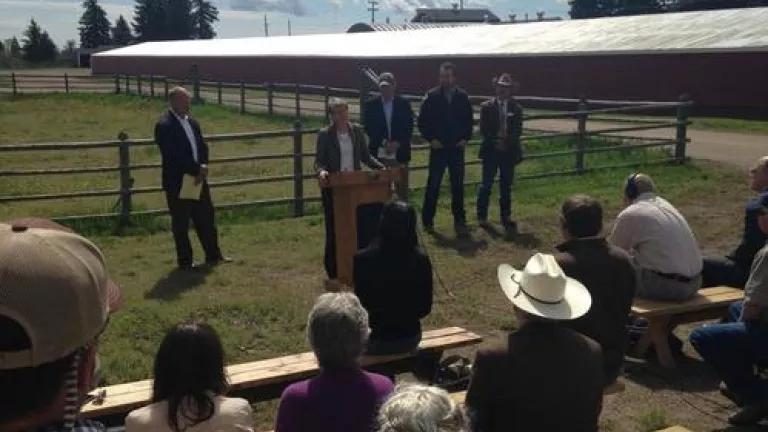
(Photo: Secretary of the Interior Sally Jewell announced the BLM's conservation plan for the greater sage-grouse today in WY)
Today the Department of the Interior (DOI) announced the release of the Bureau of Land Management's (BLM) final greater sage-grouse recovery plan. This plan is a significant step in the right direction for sage-grouse conservation. With population numbers dwindling and habitat at a mere fraction of its historical range, this iconic Western bird has become a hot button issue over the last few years.
The BLM's plan addresses sage-grouse conservation on a landscape level, taking into account years of collaborative efforts between DOI, the BLM, 11 Western States, and numerous stakeholders throughout the West. The plan was informed by the best available science to protect the sage-grouse and other sagebrush-dependent species like mule deer, pronghorn, elk, and golden eagles. A healthy habitat doesn't just benefit wildlife--sagebrush ecosystems bring in over $1 billion each year for local businesses and Western states. And because of the stakeholder and state involvement in the process, the plan is structured to prioritize local economies--and Westerners' outdoor way of life--throughout the region.
While not perfect, this plan includes various stipulations that address the most crucial issues imperiling the species--the loss and degradation of sage-grouse habitat. Among other things, the plan proposes to strategically curtail the permitting of new development on federal lands in the most critical habitat and sage-grouse breeding areas, where surface disturbance and fragmentation have proven to be devastating to the species. Activities including hard-rock mining, oil and gas drilling, and coal extraction are particularly impactful when these operations have been permitted in the most sensitive habitat. The plan proposes a number of tiers of mitigation to save the species. The most ambitious tier will restrict the federal permitting of new activities in core habitat. A second tier will limit surface disturbance, but afford added flexibility for permitted activities that occur in more general sage-grouse habitat.
But much more is needed to restore America's sagebrush steppe. The DOI recovery plan focuses on curbing the impacts that wildfire can have on greater sage-grouse populations, but does not adequately address the primary cause of those fires, which is the introduction of volatile invasive grasses that are thriving and spreading throughout the range, particularly cheat grass. Cheat grass did not appear in the West in a vacuum, decades of inaction on management of federally permitted livestock grazing has created ecological conditions that allow cheat grass and wildfire to thrive. Unfortunately the plans do little to address how best to manage livestock grazing in a manner that will further reduce the spread of cheat grass, and consequently devastating wildfires.
For those reasons, we believe there is definitely room for improvement, but with today's announcement, DOI has demonstrated a real commitment to conservation at a regional scale. And while the plan should be seen as the floor for sage-grouse conservation, not the ceiling, it provides the tools necessary to advocate for even more substantial and effective sage-grouse protections in the future. And we look forward to working with the administration to do just that.
